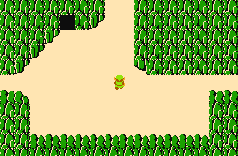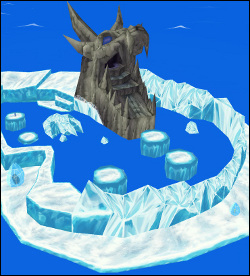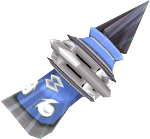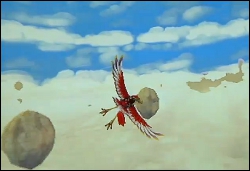How the Zelda Series Encourages Exploration
Posted on August 26 2011 by Djinn
 The Zelda series has always been known for open-ended gameplay, allowing for players to freely choose where they wish to go. The series is based on exploration and the player’s curiosity; when you explored, you were rewarded. The game structure promoted exploration; after every dungeon there would be places to explore that the player had not been to before and new places that could be reached that were previously inaccessible. The very first Legend of Zelda in 1987 did not share the standard structure of following a level to the end, and then moving on to the next. You were placed in a large expansive world without even a weapon. The player was enticed to look around and see what could be found. Link started out in a small space nearby a curious cave, baiting you to enter and be rewarded with your first sword. This instilled the concept to the player that they had to discover and stumble upon everything personally. The game did not tell you what to do and where to go, outside of a few hints occasionally given by the mysterious old man. In order to save Hyrule the player had to explore. It was up to the individual to discover where the various dungeons might be by searching throughout the map. Not every secret found was beneficial; some required Link to pay for damages. But even in paying one could still be amazed at what was found and become obligated to explore some more. This tradition of the player searching then being rewarded for what they have found has continued throughout the series.
The Zelda series has always been known for open-ended gameplay, allowing for players to freely choose where they wish to go. The series is based on exploration and the player’s curiosity; when you explored, you were rewarded. The game structure promoted exploration; after every dungeon there would be places to explore that the player had not been to before and new places that could be reached that were previously inaccessible. The very first Legend of Zelda in 1987 did not share the standard structure of following a level to the end, and then moving on to the next. You were placed in a large expansive world without even a weapon. The player was enticed to look around and see what could be found. Link started out in a small space nearby a curious cave, baiting you to enter and be rewarded with your first sword. This instilled the concept to the player that they had to discover and stumble upon everything personally. The game did not tell you what to do and where to go, outside of a few hints occasionally given by the mysterious old man. In order to save Hyrule the player had to explore. It was up to the individual to discover where the various dungeons might be by searching throughout the map. Not every secret found was beneficial; some required Link to pay for damages. But even in paying one could still be amazed at what was found and become obligated to explore some more. This tradition of the player searching then being rewarded for what they have found has continued throughout the series.
When the 3D games came around players were immersed within a full environment. Now it was no longer a matter of moving left or right around bushes and rocks, you were actually wandering within an expansive world. The 3D environment brought with it many more obstacles and places beyond an ordinary overworld. Now the player had the ability to take Link deep underwater, scale tall mountains, travel through the streets of busy cities, or even reach the unknown locations high into the sky. The old 2D overworld was replaced with Hyrule Field which looked empty enough at the beginning, but later more would be revealed as the adventure went on. The story of the later games changed how the player would be introduced to the new vast overworlds. Link would begin in a small village, isolated from the larger land of Hyrule and completely detached from the events therein. After some special event took place that gave Link his purpose, he would then set off away from his home and enter the land of Hyrule for the first time. This would coincide with the player viewing the greater world for the first time. The player was meant to see the amazing wide new world and learn of its secrets just as Link does within the game.
 The Great Sea introduced in The Wind Waker brought in a new level of venturing into the unknown. Young Link sailed off from his secluded home on a small boat into the open ocean with only an empty sea chart. Only by personally reaching each space did the player finally fill all the spaces on the map. Some of the islands discovered might be friendly places inhabited by locals who would help you, others contained dungeons, and then there were a few with mysterious rock formations that drew the player in. Leaving them wondering, “Just why was it there, what purpose did it serve?”
The Great Sea introduced in The Wind Waker brought in a new level of venturing into the unknown. Young Link sailed off from his secluded home on a small boat into the open ocean with only an empty sea chart. Only by personally reaching each space did the player finally fill all the spaces on the map. Some of the islands discovered might be friendly places inhabited by locals who would help you, others contained dungeons, and then there were a few with mysterious rock formations that drew the player in. Leaving them wondering, “Just why was it there, what purpose did it serve?”
During adventures through Hyrule there would always be the occasional interestingly placed bush or rock in the middle of the path or detached from a formation. This causes the player to ask themselves, “Why is that there? There must be a reason.” Most often they were a marker for a hidden cave of a hiding villager or even a Moblin willing to pay Link not to reveal them. The rewards for discovering these hidden locations often came in the form of a Heart Container, leading the player to look even harder for more, burning down any strange bush or bombing all rocks that may or may not even be hiding anything at all. This trained the player to recognize any strange and unusual obstacles placed on the map. Eventually one would immediately become wary of every little bush in the path, each rock, and even waterfalls began to arouse suspicion. Within the dungeon you cannot help but bomb any wall nearby hoping to discover a new and uncharted room. Many secrets might not be hidden at the edge of the map, but in places that Link had passed by several times before, sometimes completely unaware of their existence or incapable of unlocking them until a later time when a specific item was obtained.
While the majority of the games do allow the freedom of open-ended gameplay, often you did still require a specific item found in a dungeon to be capable of reaching the next. Some areas of the map could not be reached by foot alone, some help was needed. Many longstanding items that have become well known in the Zelda series were valued for their ability to unlock secrets and reveal hidden locations. The Candle and later the Lantern has been a very valuable tool for adventurers in Hyrule for not only lighting their way through a dark cavern, but for burning away brush to reveal hidden staircases or caves beneath them. The Bomb has become one of the most valuable items in the series for blowing away barriers and unlocking hidden locations. Not only did it have uses in the overworld but it could also be used within the dungeons as well. Most often an observant player would notice a strange crack in the wall of a dungeon, possibly leading one to think “What if I attempt to break it further?”
 Other items which had a single purpose such as transportation were also valuable for helping the player reach hidden locations that could not have been reached on foot. The original Flute which later evolved into the Ocarina originally was meant for easy and quick movement across the map. However playing it in certain areas would reveal hidden locations that were just ordinary scenes before. The Ocarina of later games was very useful for its various abilities that seemed normal or mundane at first. Some new areas could be reached simply by playing the Song of Storms and creating rain, or the Sun’s Song, changing night into day. Sometimes there would be a story-driven purpose behind using the songs that would familiarize the player with the idea that something as simple as calling rain could actually be used to open locations up for exploration, leading one to attempt it in other parts of the game to see if there might be a similar result.
Other items which had a single purpose such as transportation were also valuable for helping the player reach hidden locations that could not have been reached on foot. The original Flute which later evolved into the Ocarina originally was meant for easy and quick movement across the map. However playing it in certain areas would reveal hidden locations that were just ordinary scenes before. The Ocarina of later games was very useful for its various abilities that seemed normal or mundane at first. Some new areas could be reached simply by playing the Song of Storms and creating rain, or the Sun’s Song, changing night into day. Sometimes there would be a story-driven purpose behind using the songs that would familiarize the player with the idea that something as simple as calling rain could actually be used to open locations up for exploration, leading one to attempt it in other parts of the game to see if there might be a similar result.
The well-known Hookshot was also incredibly valuable for its ability to help Link reach high and far areas that never would have been accessible before. It had many uses while within a dungeon, but on the outside it was still the most versatile tool for reaching any far-off cliff, the tops of trees or roofs of buildings. Other variations came later that included the Grappling Hook or the Clawshot, also with a similar idea in mind, helping Link reach what were previously unreachable areas either in dungeons or out in the world. Normally many previous areas that were once thought to contain nothing now revealed many hidden secrets and items for the taking. These items gave a greater level of freedom to the player allowing them the chance to wander easily in higher places and across large pitfalls that might have been assumed to be impossible to cross or reach.
Various strength-enhancing items also go back to the very first game with the Power Bracelet that later evolved into the Goron Bracelet and the Power Glove. After obtaining one of these, many of the plain rocks that Link had passed by, sometimes near the very beginning of the game, would reveal hidden item, caves, or even dungeons beneath them. This reminds the player that all these once ordinary pieces of scenery that the player had seen and ignored throughout the game were suddenly important. They might all be hiding something of interest but were previously background objects that were thought to be impossible to move.
 Throughout the years the Zelda series has and will always continue to entice players to constantly wander beyond the set path. Fortune favors the bold and that is no less true in Hyrule. The rewards for attempting to find out what might be under a certain strange rock or just beyond a cliff are too enticing to leave them alone. If it cannot be reached now, that does not mean it cannot be reached forever. Maybe later on there would be some device or magic that would allow someone to obtain it. From what has been seen of the upcoming Skyward Sword it appears that Nintendo is not about to lose this important aspect of the series. Seeing the many islands floating all over the clouds around Skyloft only make me want to venture to them even more. Past experience has taught me that there absolutely must be something hidden on each of them even if it might only be a small chest containing a gold rupee.
Throughout the years the Zelda series has and will always continue to entice players to constantly wander beyond the set path. Fortune favors the bold and that is no less true in Hyrule. The rewards for attempting to find out what might be under a certain strange rock or just beyond a cliff are too enticing to leave them alone. If it cannot be reached now, that does not mean it cannot be reached forever. Maybe later on there would be some device or magic that would allow someone to obtain it. From what has been seen of the upcoming Skyward Sword it appears that Nintendo is not about to lose this important aspect of the series. Seeing the many islands floating all over the clouds around Skyloft only make me want to venture to them even more. Past experience has taught me that there absolutely must be something hidden on each of them even if it might only be a small chest containing a gold rupee.



